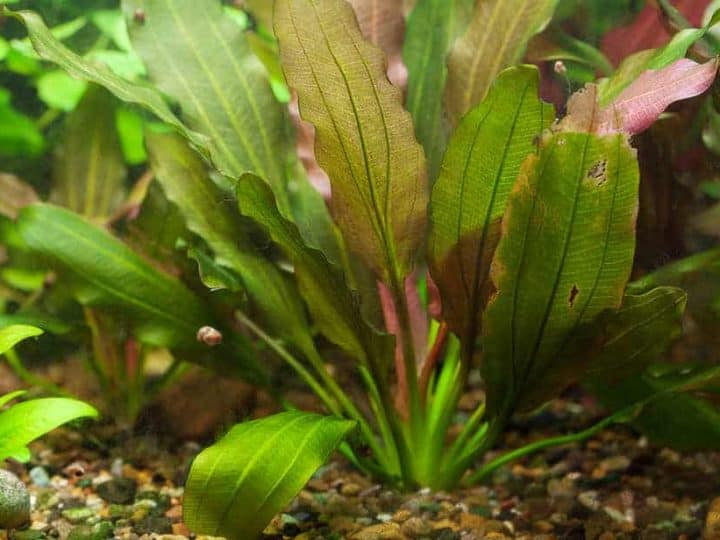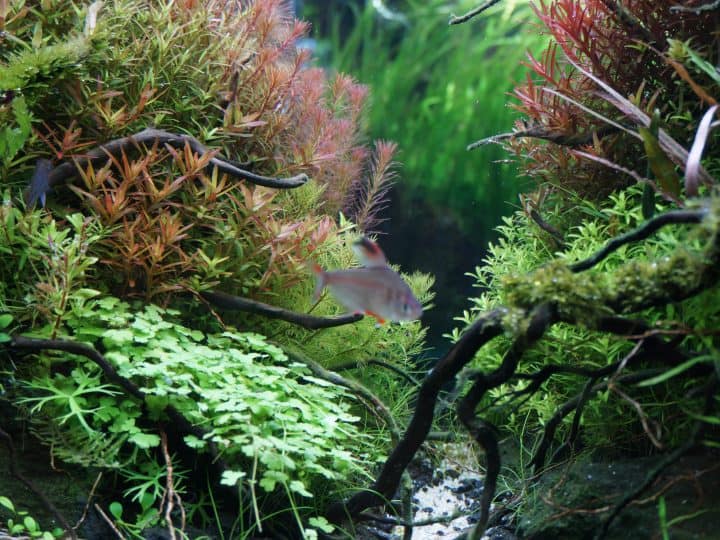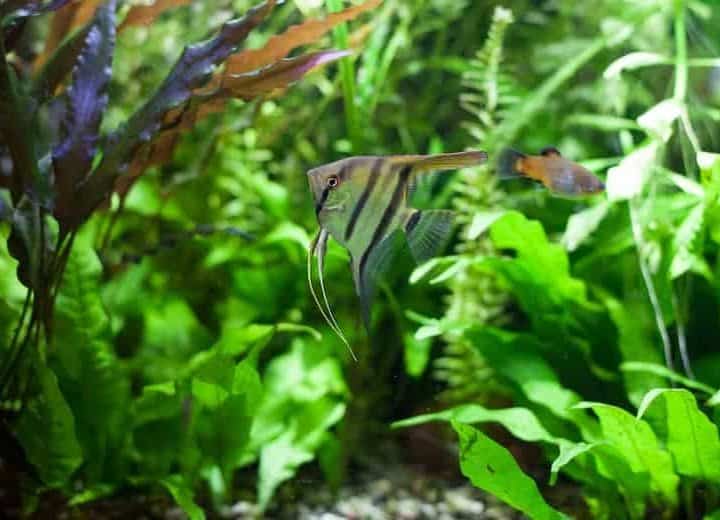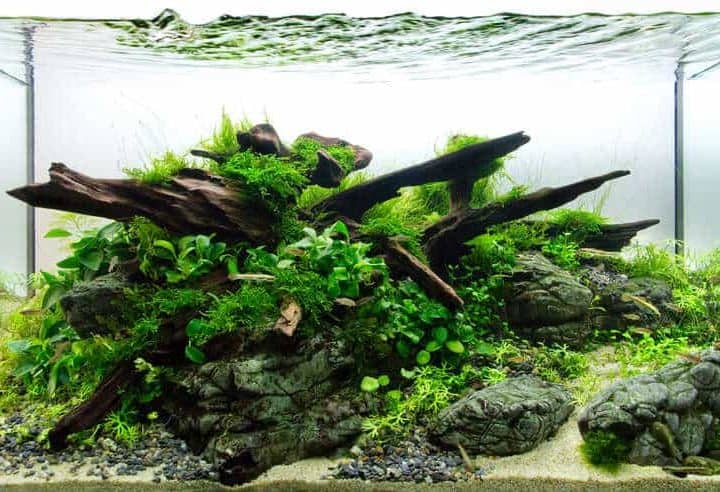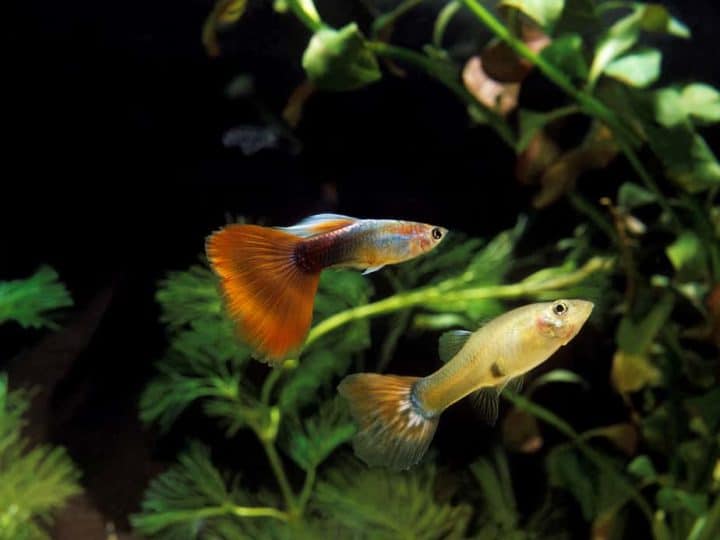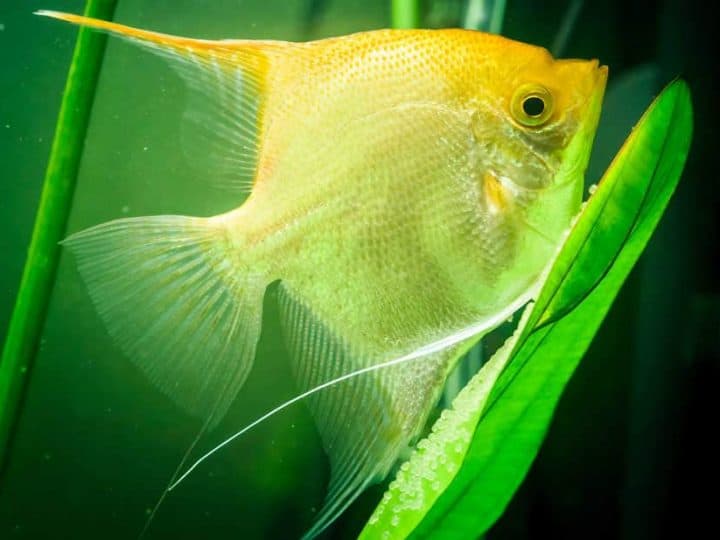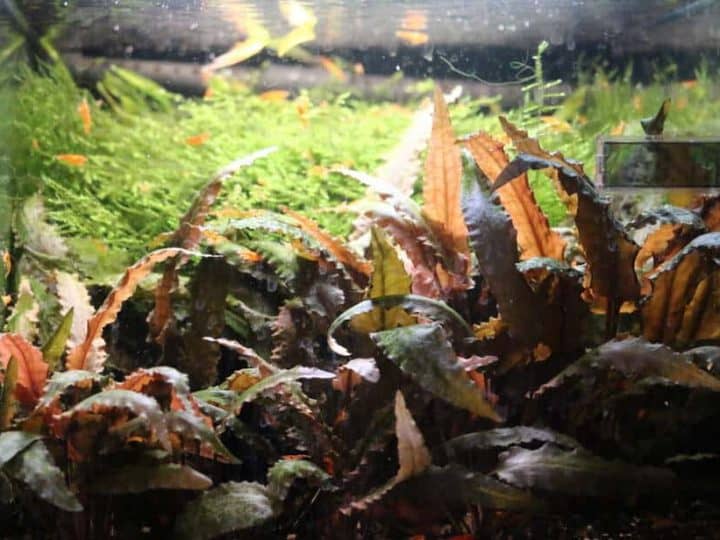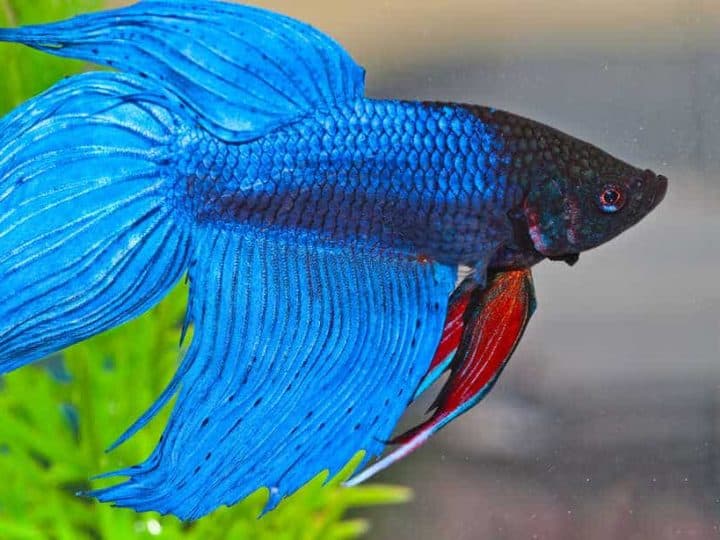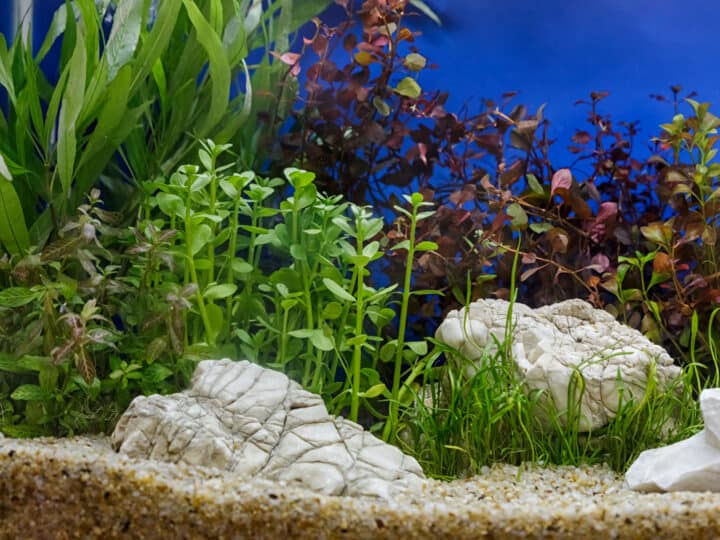Plants in aquariums provide oxygen for aquatic creatures like fish, turtles, etc. If you are looking for some red aquarium plants to adorn your fish tank then there are quite a few options out there.
Alternanthera Reineckii, Red Tiger Lotus, Rotala Yao Yai and Rotala Macrandra are some of the most popular red aquarium plants to plant in your aquarium. But there are plenty of other options to choose from. So, finding just the right one that meets your taste is not that difficult.
I put together a list of 11 of the best red aquarium plants that are popular among aquarium owners. This should make your research a bit easier and help you find just the right one for your planted tank.
Great Red Aquarium Plants for a Planted Tank
Choosing the right plant for your aquarium can be perplexing and rightfully so. Here I’m providing you a list of eleven plants that I am sure you’ll love. Other than that, I will shed some light on their maintenance, if any specific care is required, their life span and much more.
1. Alternanthera Reineckii
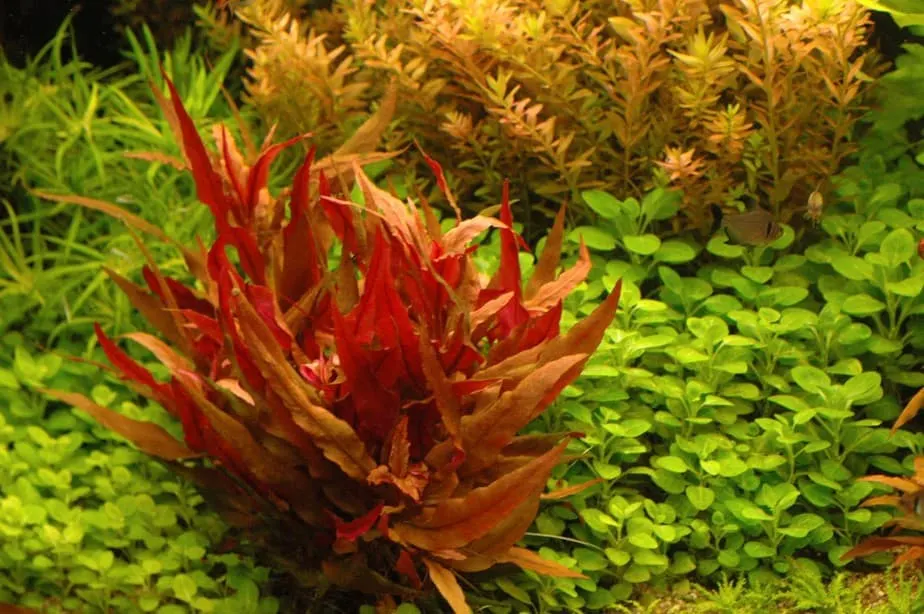
Red aquarium plants are difficult to grow and that’s where Alternanthera Reineckii thrives. This aquatic ornament is way easier to grow and maintain than any of its counterparts. It has different varieties. Among them, Alternanthera Reineckii “mini” and Alternanthera Reineckii “Rosanervig” are quite popular.
The mini variety is brighter in color than others. Due to the smaller size, it is very suitable for decorating the surface of the aquarium. Taller varieties like “Rosanervig” and “Rosaefolia” are better for backgrounds. Alternanthera Reineckii is a slow grower so you get more freedom in terms of decorating.
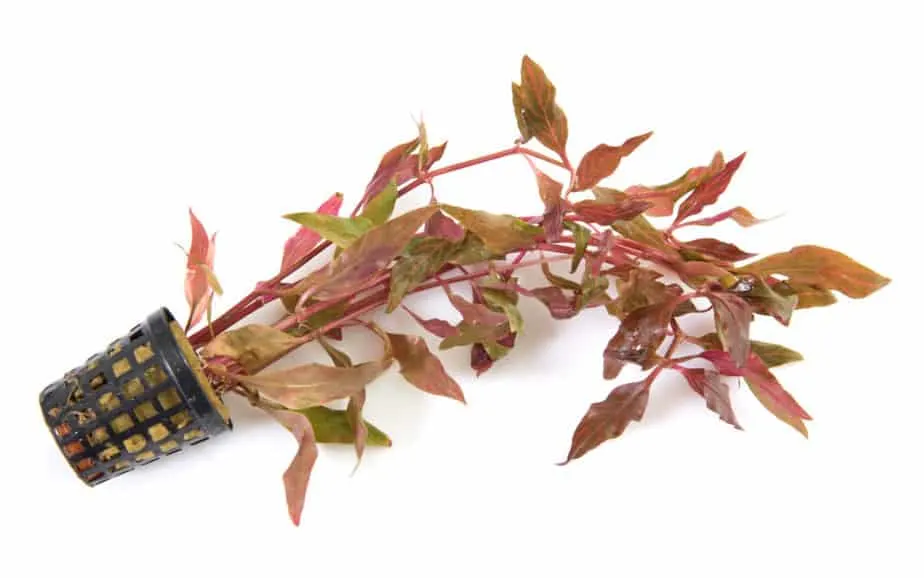
Alternanthera Reineckii is bushy in nature so if you keep small and big fishes together in your aquarium, it can work as a shelter for the smaller lives. Regular trimming is good for its growth. But faulty trimming can result in inadequate growth. Look to trim healthy-looking tall branches on the top. It may seem scary but yields better results in turn.
Alternanthera is not CO2 hungry as other red plants. However, adequate lighting is needed for its survival and aesthetic. Proper algae management is vital for its growth. Algae often cover its leaves and end up killing the entire plant. Just proper lighting, a soil-based substrate, and algae management are enough for them to stay healthy and last their entire lifetime.
2. Red Tiger Lotus
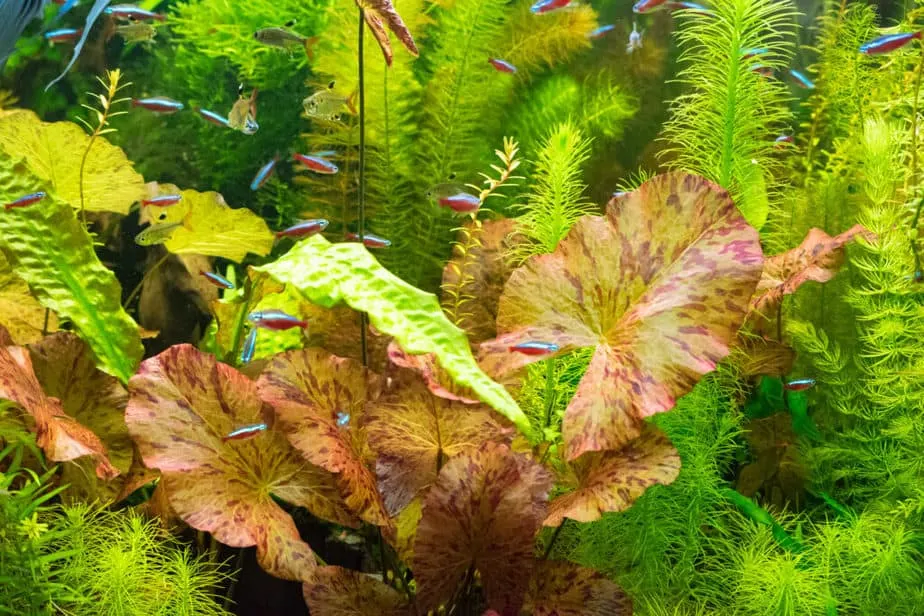
The red tiger lotus is another super red plant that is widely used in aquariums. It originated from West Africa and Southeast Asia. What many people may not know is that the red tiger lotus is a water lily. That is why it can be found in shallow and stagnant waters with other members of the water lily family.
The red tiger lotus looks amazing inside aquariums due to its red-colored arrow-shaped leaves. It grows extremely fast and doesn’t require any special care to display its best colors. On an important note, if the plant is deprived of sufficient iron, it might start producing slightly greenish leaves instead of red.
This aquatic décor grows very rapidly. Also, it takes lots of nutrients so any surrounding plant might be malnourished. Aquascaping may be difficult due to its fast growth. Many enthusiasts consider limiting its growth by various means. Root containing, growth control by trimming and keeping the seeds from spreading are some of the methods.
The red tiger lotus is notorious for being nutrient-hungry. Any plants that get their nutrition directly from the water shouldn’t be placed near the red tiger lotus. It is also said that this plant releases a toxic chemical that can inhibit the growth of other plants. With proper care and aquascaping guidance, the red tiger lotus can drastically increase the beauty of your aquarium.
3. Rotala Yao Yai
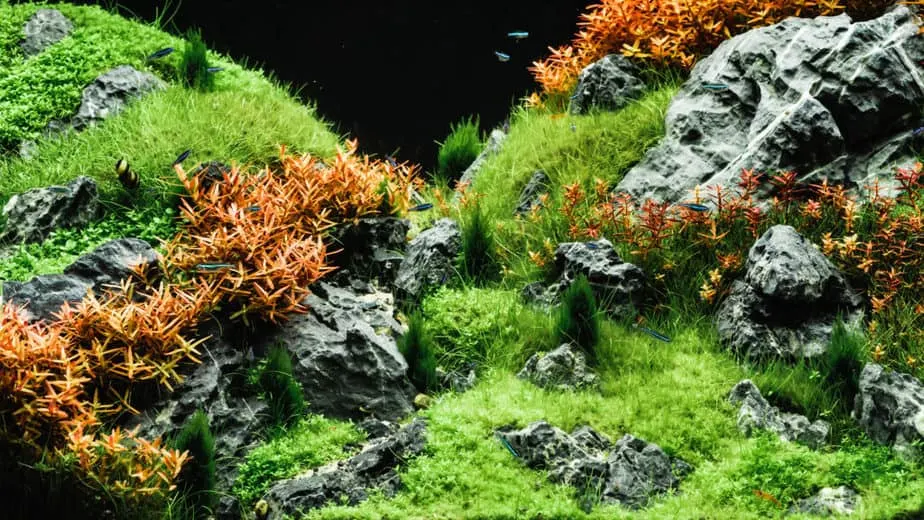
Rotala Yao is a very uncommon plant that can be one of the top choices as an aquarium plant. Even though it is considered red, it has an orange pinkish hue in its branches. It isn’t that much different than other species of its family, only more vivid in color. It has a moderate growth rate so aquascaping is viable. A small and relatively slow-growing plant like this is great for foreground use.
Due to its flashy color, Rotala Yao Yai is widely used as a background aquarium plant by many enthusiasts. The type of aquarium is also important for optimal view. Even if it’s used in any peculiar tank, its vivid color makes the look worthwhile. The pinkish hue gives this plant a unique appearance.
Proper and regular trimming is needed for making a bushy appearance if preferred. Unlike many other aquarium plants, trimming this particular species does not require any specialty. It can be uprooted and replanted repeatedly if needed. If you are a fanatic for bright and vivid colors, having a Rotala Yao Yai in your aquarium is a must.
4. Rotala Macrandra
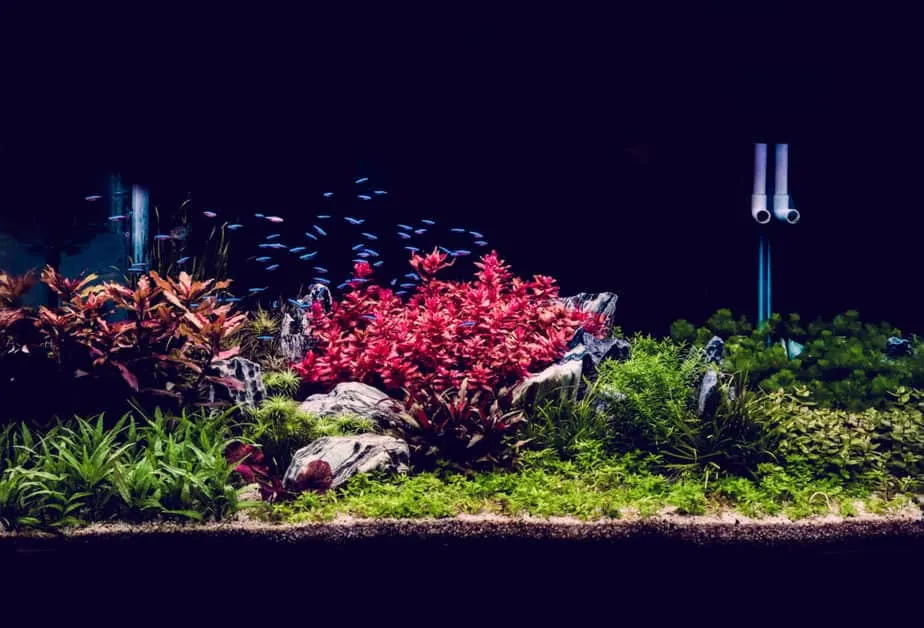
The rotala macrandra species is one of the most popular aquarium plants in the world. Its vivid red color is sure to attract any beginner, let alone enthusiasts. Its growth is fast and highly demanding in nutrients. When it’s fully grown, its dazzling beauty seems second to none compared to any aquarium plants, thanks to the vibrant red color.
It has several morphs like green, red, mini, narrow leaf, etc. The green morphs are easy to grow while the red ones are very challenging. And usually, the reds are the one which is used mostly as aquarium plants. Using a balanced mix of various morphs under optimal lighting conditions can give your aquarium an appearance like nothing else.
Rotala macrandra is a highly demanding species. It’s not that easy to grow in aquariums for beginners. Even many experts’ aquarists struggle at maintaining proper care for this particular species. Strict ph level maintenance, proper iron, and other trace elements supplement and intense lighting is crucial for its growth and exhibit the flashy colors.
If you want the best out of your rotala macrandra, you might consider injecting CO2. Even though it does not require a high level of CO2, any fluctuation is detrimental. So, to maintain a steady CO2 level, CO2 injection can be the best option.
One thing to remember is that, when using with other plants, place it in the center as it might cause color conrast issues due to its brightness, but other than that, it’s one of the best aquarium plants on this front.
5. Ludwigia sp. Red
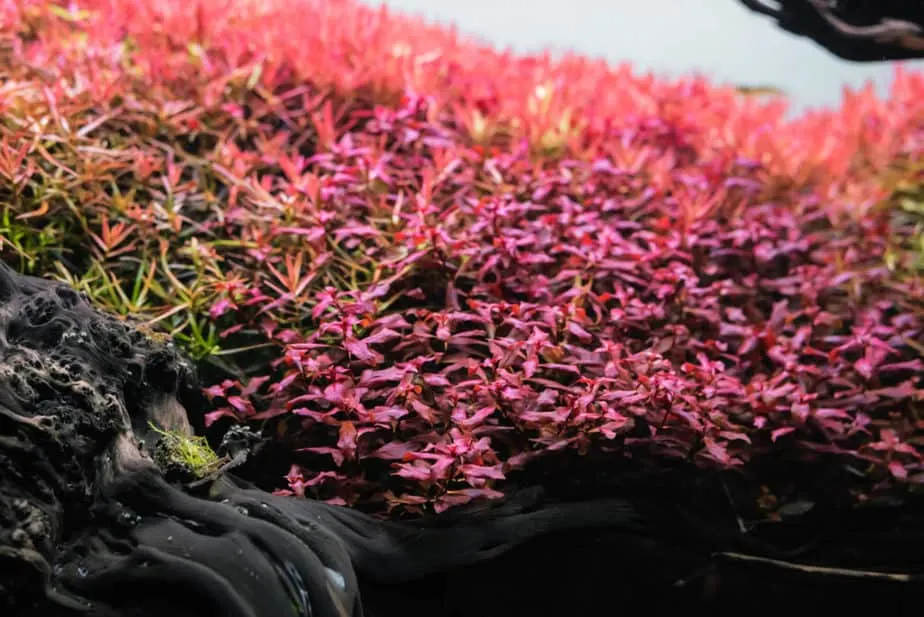
Ludwigia sp. Red is the same as ludwigia palustris, just a different morph, and it works really well for any fish tank. It’s very popular due to its similar vibrant red color as rotala macrandra but an easier growing procedure. It does not require strict maintenance of nutrient levels for proper growth. However, like most aquarium plants, it needs adequate lighting to unleash its full-color potential.
This plant is fragile so handle it with proper care. Also, despite not being highly demanding, any sudden change in water parameters can cause irreversible damage to the plant. It can grow either partially or fully submerged in the water. When fully submerged, the color of the leaves may change brownish-red or dark green.
Due to its height, it can be used as a mid or background plant in the aquarium. Ludwigia sp. Red can form a bushy appearance impacting the visuals of your aquarium. But to achieve that, regular trimming must be done. A common misconception about Ludwigia sp. Red is that there is a “mini” variety available. In reality, those are just smaller plants due to a lack of nutrition.
If you want the maximum red color that it can offer, don’t just rely on natural CO2. Try CO2 injection with high-intensity lighting. A strong red or blue light spectrum is guaranteed to enhance the color to its fullest. If you can take proper care, Ludwigia sp. Red can be the best alternative to its more demanding analogues.
6. Ludwigia Repens
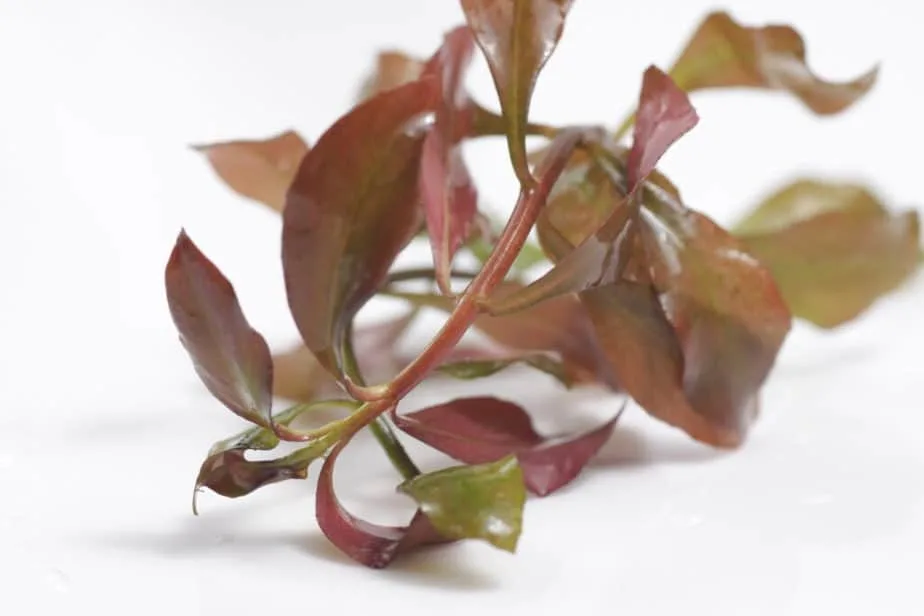
Ludwigia Repens is a very beginner-friendly aquarium plant. It is recommended to novice aquarists by many experts. It is beautiful, colorful, easy to grow, and goes well with any tank regardless of the size. Generally, smaller tanks are avoided but, in the end, it depends on your preference.
Its leaves and stock have a dark red color. So, planting them among green plants shall provide better contrast. As for the growth rate, it is very slow. So, the decoration is very convenient. When fully grown, the ludwigia repens can give a bushy appearance. Regular trimming is required for that.
If you have a large aquarium it’s your lucky day. Planting multiple together enhances the decoration. It is less demanding due to its strong roots and overall sturdy root system. So, picking the right substrate shouldn’t be a headache. However, if the substrate you choose lacks any essential nutrients. In that case, supplying artificial nutrients can compensate for that.
As for the dark red color which is the main attraction, you must carefully maintain the lighting system. Also tweaking the nitrate and phosphate shall bring better results.
7. Lagenandra Meeboldii Red
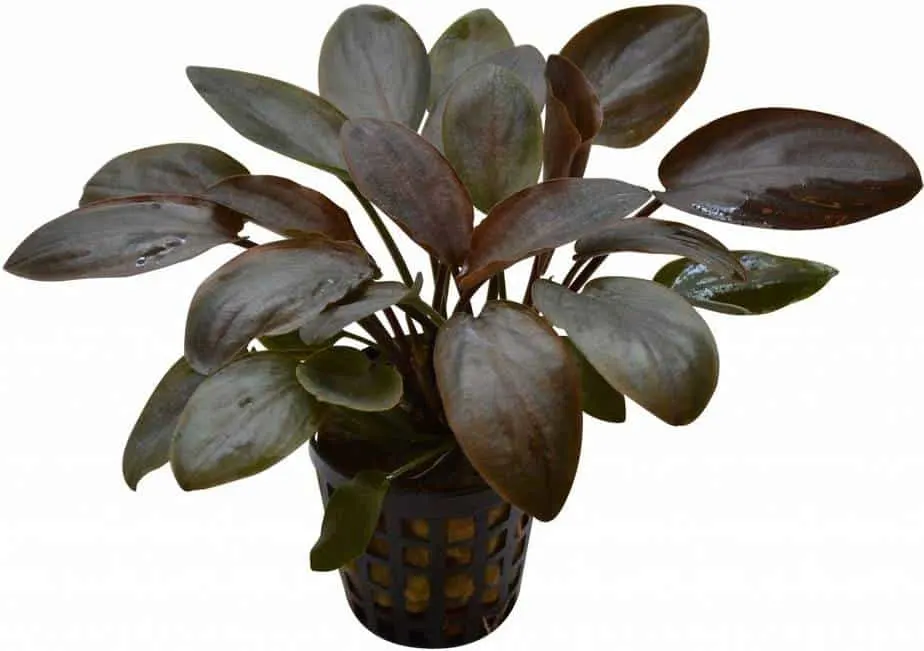
This medium-sized aquarium plant is abundant in south India. It has various shades of color. From green with bright violet to red-violet and plain red, it has many variants. The different colors can be on the same leaf. Its red and green variant is mostly used in aquariums. These two were collected from India and later developed in Germany.
It is used as a midground plant due to its small size. Initially, its leaf color is greenish but later changes to different shades depending on the growing condition. Its color is consistent and largely depends upon various conditions, it can be used either as contrast media or harmonize with other plants.
Its growth is slow and less demanding. So, you can grow it in almost any aquarium. Its root is structurally large so using a nutrient-rich substrate is particularly beneficial. Its leaves have a special pattern which gives shadow to surrounding plants. If you are planning to use it with other plants, keep this fact in mind.
Co2 injection and intense lighting will enrich the color. For normal growth, medium lighting is enough, but lots of light will result in much brighter colors and a really beautiful focal point. For this p[lant,
8. Barclaya Longifolia Red
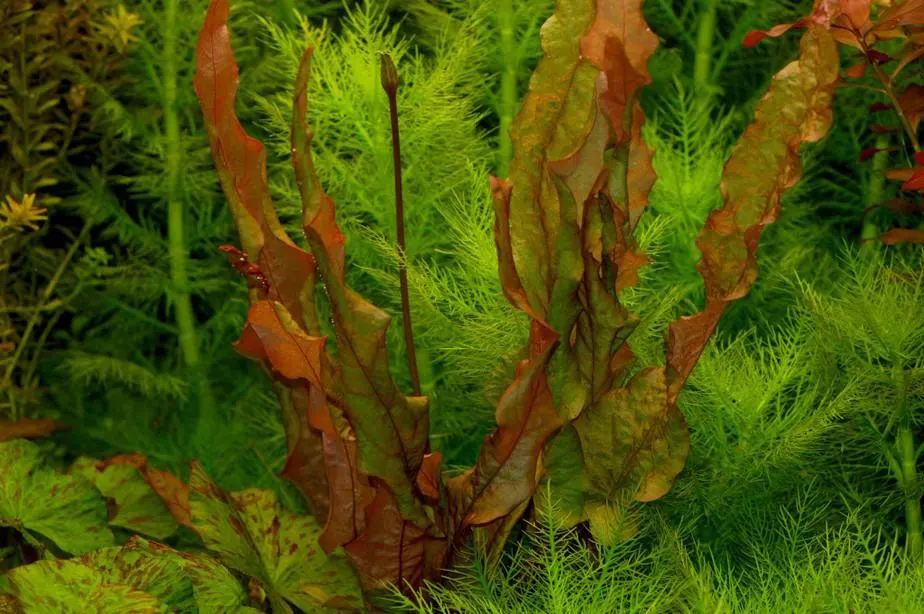
Barclaya Longfolia Red is a wonderful aquarium plant due to its sparkling color and easy growth. It is native to Southeast Asia. Like red tiger lotus, Barclaya Longfolia Red is also a water lily. But unlike the waterlily family, its leaves stay fully underwater. This particular trait makes it more suitable as an aquarium plant.
Its growth rate is medium so the decoration is in your hands. It can be placed as a mid or background plant in the tank. The nutritional requirement is not demanding. As far as lighting is concerned, medium lighting will do. You can use incandescent lights as it will make the color brighter. Strong and direct sunlight or any other light source should be alleviated if any.
Its root is very weak so you have to be careful when choosing a substrate. Large granule river sand and pebbles are recommended. Even then, regular cleaning of the substrates is required. Regular water changing and feeding isn’t essential. You can feed it once every 9-10 days with essential mineral supplements.
Barclaya Longfolia is adored by many aquarists. It works as an excellent midground decoration and shelter for small fishes. This plant can magnify the look of any aquarium without any doubt.
9. Bacopa Colorata
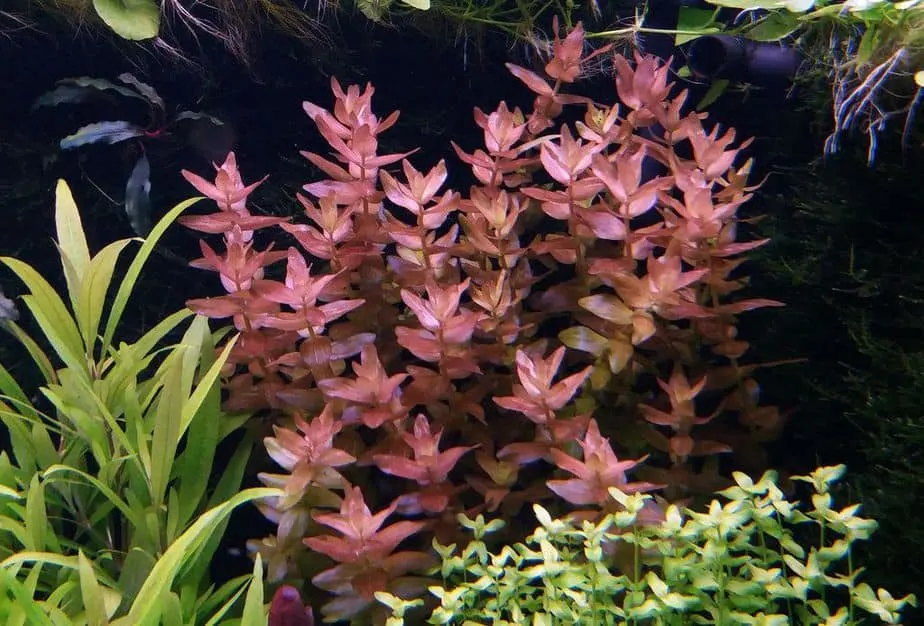
Bacopa Colorata is one of those few plants in this list that originates in the USA. It is ridiculously less demanding which makes it very convenient for beginners. Its branches spread from the bottom giving it a spectacular look. Its growth is slow, so planning and decorating your aquarium is very effortless.
If you are reluctant to manage extra light sources, this plant is for you. They grow fairly well in low to medium lighting. So, the normal daylights inside your house will do. However, if you want to influence the color of the leaves, putting some extra lights will do the job. As for tank size, it can grow in even the smallest of tanks.
Bacopa Colorata is one of the most versatile aquarium plants. They are so low demanding that they do not require anything special, not at all. It can thrive without CO2 injection, low lights, any substrate, small tank, etc. However, if you want robust growth and vivid colors, take care of this plant like any other plants on this list.
10. Persicaria Sao Paulo
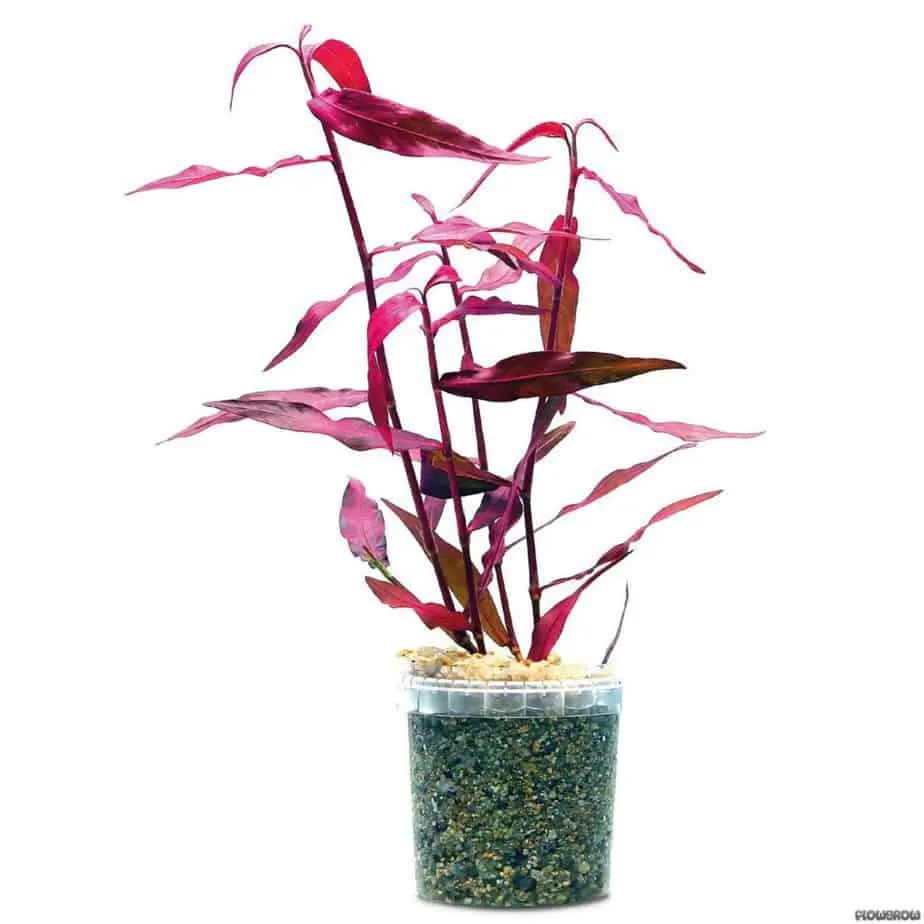
Persicaria Sao Paulo as you might’ve already guessed, originated from Brazil. It is an excellent midground plant suitable for any aquariums. It looks particularly great in contrast with green colored plants. There is no harm if you want to solely use it in the aquarium. Its color becomes magenta under optimal conditions; hence it is considered a red plant.
Its growth is moderate. Both the ph level and the temperature have a big range. So, you can say that by default, it is not very demanding. Water hardness can be soft to hard. A little-known fact about this plant is that if it merged in palladium during its growth, the purple color of its leaves intensifies.
Persicaria Sao Paulo is relatively easy to grow. Lighting can be anywhere from low to moderate. Many aquarists consider it the most intensely colored aquarium plant-available these days. If you keep it under the right conditions and proper lighting, its signature magenta color will develop. For propagation, trim the top and place it on the substrate.
11. Myriophyllum Tuberculatum Red
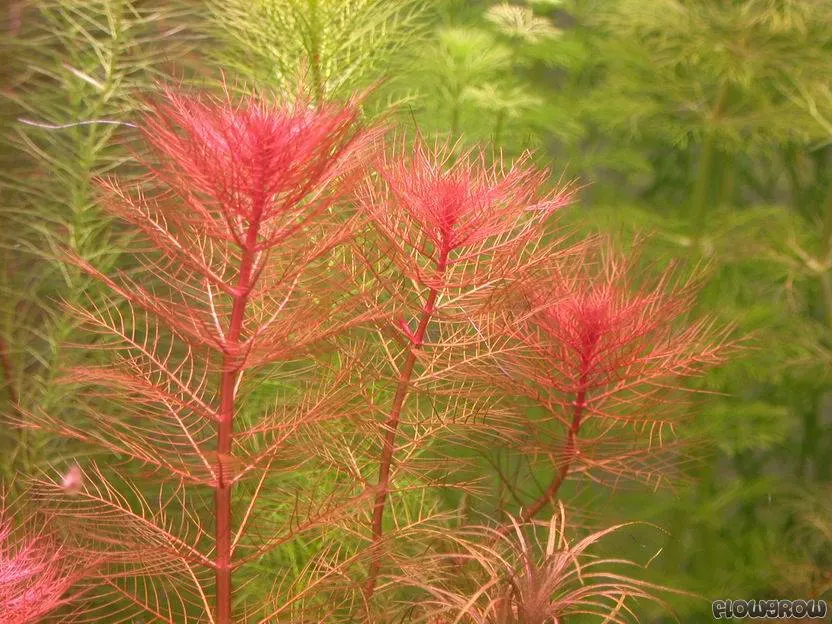
The last in our list, Myriophyllum Tuberculatum red, is not an easy plant to grow. Its leaves are like feathers and have an intense red color. It originated from Southeast Asia and also available in Australia. Every parameter must be maintained strictly for this plant to grow properly. Else, you might be utterly disappointed.
Myriophyllum Tuberculatum requires intense lighting, at least 0.8 watts per liter of the tank. As far as nitrate and phosphate levels are concerned, 5 – 15 mg/l and 1 – 2 mg/l have to be maintained strictly. If any of these parameters fails to match, serious growth retardation might result. Iron and other micronutrients are also needed to prevent discoloration of the leaves.
Its red color shall accentuate if placed in the middle of the tank. It can also be used in the background. As soon as it grows the water surface, it will create a bush. So, make sure that other plants surrounding it aren’t deprived of lighting. As its CO2 requirement is very high, CO2 injection is essential to guarantee optimum growth.
If you can maintain every parameter properly, Myriophyllum Tuberculatum red can be a very beautiful aquarium plant for both experts and beginners alike.
How to Get Stronger Reds and Richer Colors?
If you want to get stronger reds and richer colors in your aquarium plants, there are a few things you can do. First, make sure the plants have enough iron in their environment. Iron tablets or liquid fertilizer can be added to the water to provide this nutrient.
Secondly, ensure that the aquarium has adequate lighting for photosynthesis. Red aquarium plants need more light than other types of aquatic vegetation, so it is important to adjust the lighting accordingly. Having strong LED lights is beneficial for these kinds of plants.
Finally, consider adding a liquid fertilizer specifically designed for red plants to help them reach their full potential. Nitrogen, phosphorus, and potassium are all very important for red aquarium plants to grow, not to mention that some CO2 supplementation can help as well.
For red stem plants a liquid fertilizer works best. With these steps taken, you should be able to achieve strong reds and richer colors in your aquarium plants.
In addition to proper lighting, other important factors for keeping red aquarium plants healthy include regular pruning, nutrient-rich substrate, and water changes.
Pruning helps to keep the plant healthy by removing dead or dying leaves, while a nutrient-rich substrate allows the roots to absorb essential minerals. A substrate that is live will be the most beneficial on this front. Finally, regular water changes help to remove any built up toxins and debris that can harm your plants.
Key Takeaways
In this article, I have discussed the best red aquatic plants for your aquarium. They not only do the job of a normal green plant but also elevates the aesthetics of your aquarium to a whole new level with their sharp and vivid red color. Although they sometimes need extra efforts like special lighting set up or regular fertilization, they are worth it.
I hope that through this article “Best red aquarium plants” I was able to provide all the necessary information to help you pick the best one for your aquarium. Thank you for going through the entire article. Have a great day! Remember that nutrients, lighting, substrate, and more, can all make a big difference here.

